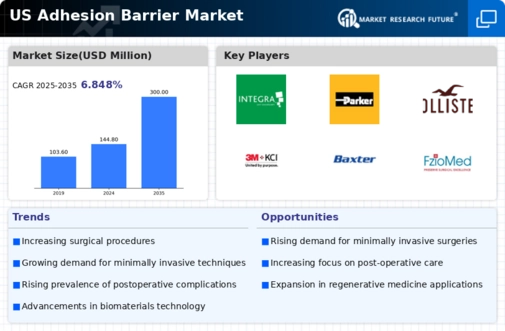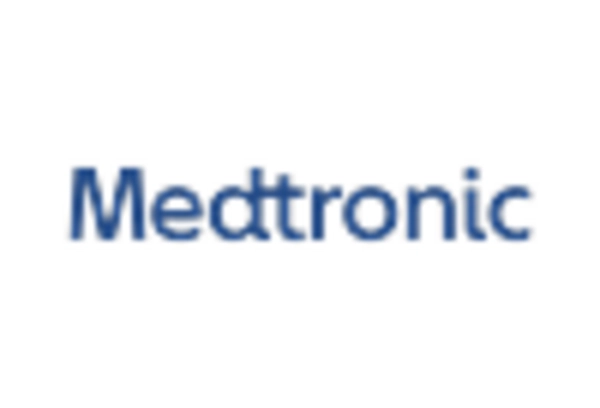Rising Surgical Procedures
The increasing number of surgical procedures in the US is a primary driver for the adhesion barrier market. As healthcare providers perform more surgeries, the risk of post-operative adhesions rises, necessitating the use of adhesion barriers. In 2025, it is estimated that over 50 million surgical procedures will be conducted annually in the US, leading to a heightened demand for effective adhesion prevention solutions. This trend is particularly evident in gynecological, orthopedic, and abdominal surgeries, where the incidence of adhesions is notably high. Consequently, the adhesion barrier market is poised for growth as hospitals and surgical centers seek to minimize complications associated with adhesions, thereby improving patient outcomes and reducing healthcare costs.
Supportive Regulatory Environment
The regulatory environment in the US is becoming increasingly supportive of the adhesion barrier market. Regulatory bodies are streamlining the approval processes for new adhesion barrier products, which encourages innovation and market entry. In 2025, it is anticipated that the approval timelines for new adhesion barriers will decrease, allowing manufacturers to bring their products to market more swiftly. This supportive regulatory framework is likely to foster competition and drive down costs, ultimately benefiting healthcare providers and patients alike. The adhesion barrier market stands to gain from this trend, as a more efficient regulatory process can lead to a wider variety of options for clinicians.
Technological Innovations in Adhesion Barriers
Technological advancements in the development of adhesion barriers are significantly influencing the market landscape. Innovations such as bioresorbable materials and advanced delivery systems are enhancing the efficacy of adhesion barriers. In 2025, the market is expected to see a surge in the adoption of these novel products, which offer improved performance and patient outcomes. The adhesion barrier market is likely to expand as manufacturers invest in research and development to create more effective solutions. This focus on innovation not only addresses the clinical needs but also aligns with the growing demand for minimally invasive surgical techniques, further propelling market growth.
Growing Demand for Minimally Invasive Surgeries
The rising preference for minimally invasive surgical techniques is a significant driver for the adhesion barrier market. As more surgeons opt for laparoscopic and robotic-assisted surgeries, the need for effective adhesion prevention becomes critical. Minimally invasive procedures are associated with reduced recovery times and lower complication rates, yet they still carry the risk of adhesions. In 2025, the market is projected to grow by approximately 10% as the adoption of these techniques continues to rise. The adhesion barrier market is thus positioned to benefit from this trend, as healthcare providers seek to enhance surgical outcomes and patient satisfaction.
Increased Awareness of Post-Surgical Complications
There is a growing awareness among healthcare professionals and patients regarding the complications arising from post-surgical adhesions. This awareness is driving the adhesion barrier market as both surgeons and patients seek to mitigate risks associated with adhesions. Educational initiatives and clinical studies highlighting the benefits of adhesion barriers are contributing to this trend. In 2025, it is projected that the market will witness a growth rate of approximately 8% as more practitioners adopt adhesion barriers as a standard practice in surgical procedures. The adhesion barrier market is thus benefiting from this shift in perception, as the emphasis on patient safety and quality of care becomes increasingly paramount.
















Leave a Comment